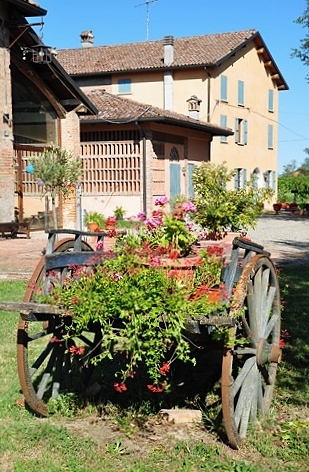
“You are arrived!”
OK. I have not switched gears on you. This is not a post just about cows – specifically….. Read on:

The King of Cheeses
Emilia-Romagna has hundreds of dairy farms that supply milk for Italy’s King of Cheeses: Parmigiano Reggiano. It is produced today substantially as it was over 800 years ago: same ingredients, same production process, and same handcrafted care.

The PDO designated region for Parmigiano Reggiano.
The region is mapped (mainly in Reggio Emilia and Parma) and legally defined by Protected Designation of Origin (PDO) regulations with production rigorously supervised by a body of authoritarian biologists and agronomists that demand and ensure consistency and quality. We had to see how this incredible cheese comes about.

I was not really sure about riding on the back of Bess even if my grandfather was holding onto me.
When growing up in Alabama, I only knew about four breeds of cows: Jersey and Guernsey for milk or Hereford and Black Angus for beef. My grandfather had a Jersey named Pet and a Guernsey named Bess. My grandmother churned their milk into a butter that was rich and sweet like no other. When she made Parkerhouse rolls to go with supper, my sister and I gorged ourselves on hot buttered rolls and ignored everything else on our plate. Well, maybe one drumstick…
Typically Parmigiano Reggiano cheese is from the milk of Holstein cows but while researching dairies to visit, I came across a variety of Parmigiano Reggiano made from the milk of the Razza Reggiana breed (razza means breed) – otherwise known as Red Cows.

Razza Reggiana Cows
In the early 1950’s there were about 41,000 Reggiana cows in northern Italy but because the breed produces a third less milk than Holsteins it lost favor. By 1981 there were only about 450 registered cows.

A partner dairy farm that provides milk to the consorzio.
Authorities within the Parmigiano Reggiano Consortium became aware of this but then re-discovered that milk from this ancient breed made more and better cheese. They partnered with a local agricultural school to increase its population.
Since beginning to commercially produce Parmigiano Reggiano from the Red Cows, there are now about 3,000 cows.
The Red Cow’s milk has a unique variation of casein (the essential protein needed for transforming milk into cheese) that ensures that the cheese will age for longer periods of time with better digestibility. For that reason, production regulations for Red Cow’s Parmigiano Reggiano specify at least 24 months of aging, compared to twelve months for traditional Parmigiano Reggiano.

The result is a cheese that, despite (and maybe because of) longer aging, has a wonderfully sweet, delicate and lingering taste. It has a straw yellow color and an elasticity of the grain. After 30 or even 40 months of aging the aroma is reminiscent of the air you can breathe in the foothills of the Apennine Mountains. It is among the healthiest of cheeses: high in calcium, so low in lactose that it is suitable for the lactose intolerant, and has one of the lowest cholesterol levels of any cheese.

The Consorzio Vacche Rosse, which is located about 40 km from Modena in Reggio Emilia, is the production center for Red Cow Parmigiano Reggiano. This was the cheese factory that we could not wait to visit.
The trip from Modena takes 30-40 minutes in morning traffic. However, I did not trust my GPS so allowed 90 minutes. This was a good thing. When we arrived in town, the GPS directed me through various streets with no sign of the dairy. After becoming thoroughly frustrated, I pulled into a service station to try to figure out where I needed to go. Luckily, there were a couple of Polizia Municipale officers waiting while their car was being washed. I approached them and found, rather quickly, that they spoke virtually no English. They did, however, recognize the written address. Somehow, they communicated to us that they would lead us to our destination when their car was ready.

Karel with her new friends!
My wife, Karel, who has never met a stranger, walked over to show them our daughter’s business card – she is a police sergeant in San Diego. They recognized the badge icon on the card and we immediately became best friends. When ready to leave, they beckoned and shouted “We bring you” and off we went. The Consorzio was fairly close to the car wash and we were able to easily follow them. After ten minutes, they pulled into the parking lot and cheerfully announced: “You are arrived!”
Next week I will give you a lesson on how to make Parmigiano Reggiano.
Ciao!
Oh my I just adore this lovely image.. All smiles here. Thank you for your delightful blog.
LikeLiked by 1 person
It is my pleasure to write it.
LikeLike
How nice to have a police escort to your lost cheese Shangri-La. I’ve learned that a journey is much more pleasant following a police cruiser than having it follow you to
your destination.
LikeLiked by 1 person
You speak from personal experience??
LikeLike
Good cheese hunting! Police escort too! These Italians know how to live! Love it! Thanks!
LikeLiked by 1 person
I love Italians. Great people!
LikeLike
Wonderful story!
LikeLiked by 1 person
I am so happy that you liked it.
LikeLike
Pingback: The Red Cow, Part 2 | UPROOTED
Pingback: The Red Pig | UPROOTED